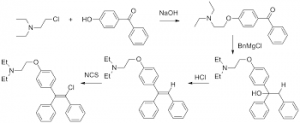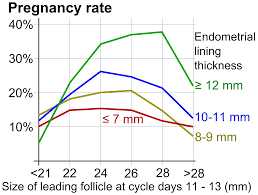Clomiphene Citrate Information And Guide
Video Link: https://vimeo.com/181469225
Video Download: Clomiphene Citrate Information And Guide 2
Video Stream: Clomiphene Citrate Information And Guide 2
Video Link: https://vimeo.com/181469224
Video Download: Clomiphene Citrate Information And Guide 1
Video Stream: Clomiphene Citrate Information And Guide 1
Clomiphene Information Guide
What is Clomiphene?
Clomiphene is a synthetic medication that can imitate the function of hormones produced by the human body known as Selective Estrogen Receptor Modulators (SERMs).
In short, Clomiphene impacts the way that the hypothalamus registers Estrogen to encourage the body to produce hormones related to ovulation in  women and the production of Testosterone and sperm in men. There are three forms of Clomiphene available in the pharmaceutical market: Omifin, Clomid, and Androxal. Clomiphene is also available in generic form.
women and the production of Testosterone and sperm in men. There are three forms of Clomiphene available in the pharmaceutical market: Omifin, Clomid, and Androxal. Clomiphene is also available in generic form.
The drug is named Clomiphene in the United States, but based on international standards, it is named Clomifene. This drug is taken orally and, dependent upon the formulation, is a light yellow or white tablet.
Clomiphene and Female Fertility
Clomiphene was first used as a fertility treatment for women. There are two forms of infertility for which Clomiphene has proven exceptionally useful—oligoovulation and anovulation.
What is Oligoovulation?
Oligoovulation refers to ovulation that occurs irregularly or infrequently during the menstrual cycle. Under normal circumstances, women ovulate about two weeks into their menstrual cycle, but certain circumstances can get this release off track.
In some cases, women only ovulate around once every fifty days or more, and under other circumstances, ovulation can simply occur at the wrong time of the cycle.
As a result of this irregularity, it is difficult for women to know exactly when conception is most possible. Clomiphene can help regulate this process, making ovulation occur more regularly and predictably.
What is Anovulation?
Anovulation is a condition in which the menstrual cycle occurs, but ovulation does not happen, which prevents the possibility of conception. Clomiphene is often used to encourage ovulation to take place in a usual fashion.
Clomiphene for General Infertility
There are clinical solid results for the use of Clomiphene for these purposes. Still, for fertility without known causes, the evidence is incomplete about the effectiveness of Clomiphene Fertility Treatment.
However, there is evidence that Clomiphene can boost fertility in patients with unknown causes of infertility. Clinical studies have varied concerning Clomiphene for this purpose. Under these circumstances, Clomiphene is shown to increase fertility to around a 5.6% chance of conception per menstrual cycle, an increase in fertility of 1.4%-4.3% dependent upon the study.
Clomiphene for Multi-Modal Fertility Treatment
Clomiphene Citrate is often combined with other fertility treatments to further increase the odds of conception.
How is Clomiphene Prescribed for Women?
Generally, for female fertility treatment, Clomiphene Therapy begins at fifty milligrams per day for five days, beginning on the third, fourth, or fifth day of the menstrual cycle.
Doing so encourages ovulation at a normalized and stable point of the menstrual cycle. In the week before ovulation, which will occur between the 15th and 18th day of the cycle, the couple should copulate frequently to optimize the chance of fertility success.
In many cases of feminine infertility, the physician will perform tests to monitor for the surge in Luteinizing Hormone, which encourages ovulation and is spurred by Clomiphene.
These tests generally take place beginning on the day the fifth dose of Clomiphene is taken and are administered daily until ovulation occurs, as shown  by affirmative Luteinizing Hormone Testing. Suppose ovulation does not occur by the 18th day.
by affirmative Luteinizing Hormone Testing. Suppose ovulation does not occur by the 18th day.
In that case, the fertility doctor may force ovulation through a 10,000 IU dose of Human Chorionic Gonadotropin if there is a follicle of sufficient size for implantation.
Interestingly enough, HCG triggering is not as effective at inducing pregnancy as monitoring and waiting for the natural release of Luteinizing Hormone.
How Is Ovulation Monitored?
There are a number of ways to keep track of cycling induced by Clomiphene Citrate:
Vaginal Ultrasound – Using ultrasound, it is possible to monitor the development of Ovarian Follicles necessary for implantation and which form preceding the release of the egg. Evidence of ovulation can also be obtained via ultrasound.
Luteinizing Hormone Testing – Luteinizing Hormone Levels increase in the days preceding ovulation or are artificially increased to induce ovulation.
Estradiol Levels – These levels are generally tested four to six days after the last Clomiphene Dose and can provide evidence of impending ovulation.
Progesterone Levels – Between seven and nine days past ovulation, Progesterone Levels should be a minimum of ten nanograms per milliliter for optimal chances of fertilization.
Testing for Active Sperm – Tests can be conducted in the days preceding ovulation to ensure sufficient active sperm for a reasonable chance of successful conception.
By Inducing Consecutive Menstrual Cycles – Administering the Clomiphene monthly encourages a healthy and regular menstrual cycle. Clomiphene treatment can be administered five of every thirty days to produce a stable pattern. If ovulation does not occur in a cycle, the dose of Clomiphene administered is often increased by fifty milligrams per cycle over the course of six months. Clomiphene is only recommended as a six-month maximum course of treatment when used as a fertility treatment.
Side-Effects of Clomiphene for Female Fertility
Most women experience no significant side effects resulting from Clomiphene Citrate Fertility Treatment. The most reported side-effect of Clomiphene is an enlargement of the ovaries. This occurs in less than ten percent of patients treated and is completely reversible.
All other side effects occur in less than ten percent of patients. The most common among these side effects are:
Abdominal Discomfort
Abnormal Bleeding from the Uterus
Hot Flashes
Headaches
Temporary Changes in Vision, including Scotoma (blind spots), Photophobia (light sensitivity), Floaters, Diplopia (double vision), and Blurred Vision
A tiny percentage of patients, less than one percent, experience the following symptoms:
Ovarian Hyperstimulation
Reversible Hair Loss (Alopecia)
Hepatitis
Hypertriglyceridemia (elevated triglyceride levels)
Like many other forms of fertilization treatment, Clomiphene increases the likelihood of triplets and twins resulting from the release of multiple eggs (ten percent of patients that conceive using Clomiphene have twins).
Potential Long-Term Risks of Clomiphene Therapy for Women
Limited research provides inconclusive evidence that using clomiphene for more than twelve months can elevate the risk of Ovarian Cancer. It may be that long-term use of Clomiphene only impacts patients who don't become pregnant over a year, which is why the therapy is generally only recommended for six months for women.
There have been no studies that have reproduced these risks, so there are many that believe that Ovarian Cancer risk is not affected by Clomiphene.
Clomiphene Does Not Lead to Neonatal Complications
No signs suggest that Clomiphene increases the risk of Genetic Abnormalities compared to the normal process of conception. Clomiphene also does not lead to an increased risk of spontaneous abortion.
How Does Clomiphene Work?
Clomiphene works by reducing the ability of Estrogen to activate receptor sites on the Hypothalamus. When the Hypothalamus receives stimulus from circulating Estrogen, it reduces signals from the production of Luteinizing Hormone by the Pituitary Gland.
A similar pharmaceutical, Zuclomifine, acts similarly but for an extended time. Although Clomiphene affects the release of steroid hormones, Clomiphene is not itself a steroid.
How Do Normal Women Reach Ovulation?
When women experience regular menstrual cycles, Progesterone and Estrogen Levels increase significantly, as released by the Corpus Luteum. This inhibits the production of Luteinizing Hormone, Follicle-Stimulating Hormone, and Gonadotropin-Releasing Hormone from the anterior pituitary and the Hypothalamus.
It is during this period that fertilization occurs. If the body doesn't experience fertilization in the days after ovulation, the Corpus Luteum breaks down because it does not receive Human Chorionic Gonadotropin signaling.
HCG is released after fertilization to encourage stable Estrogen and Progesterone levels.
 Clomiphene is administered orally in the early stages of the menstrual cycle when used as a fertility treatment. During this period, levels of Follicle Stimulating Hormone increase quickly, which leads to the production of follicles in the uterus. The follicles then produce Estrogen, which circulates through the bloodstream.
Clomiphene is administered orally in the early stages of the menstrual cycle when used as a fertility treatment. During this period, levels of Follicle Stimulating Hormone increase quickly, which leads to the production of follicles in the uterus. The follicles then produce Estrogen, which circulates through the bloodstream.
Clomiphene increases the production of Follicle Stimulating Hormone by reducing the negative feedback mechanism caused by Estrogen upon the receptors on the Hypothalamus, causing the Hypothalamus to produce quick pulses of Gonadotropin-Releasing Hormone.
As Follicle-Stimulating Hormone Levels increase, this causes the ovaries to produce more follicles, which spurs ovulation as they rupture. When using Clomiphene, ovulation generally occurs six or seven days after the last dose of Clomiphene is taken.
Clomiphene Chemistry
Clomiphene combines two isomers of the same compound, Zuclomiphene, and Enclomiphene. These are the active ingredients that both can encourage the production of Estrogen while inhibiting the activity of harmful feedback mechanisms which discourage the production of Estrogen by the female body.
In men, Clomiphene encourages the production of Testosterone by inhibiting harmful feedback mechanisms because the precursor hormones which lead to the production of Estrogen in females lead to the production of Testosterone in males.
Clomiphene Off-Label Uses
Clomiphene has proven to be highly effective for males experiencing Andropause or other forms of primary hypogonadism, which slow down the production of Gonadotropin-Releasing Hormone, Luteinizing Hormone, and Follicle-Stimulating Hormone.
As a result of its high effectiveness and lower incidence of side effects, many patients and physicians prefer Clomiphene to Bio-Identical Testosterone for many patients suffering from Low-T. This is primarily because Clomiphene is cheaper than Testosterone and easier to administer since it is taken orally.
Another reason why many patients prefer Clomiphene is that Clomiphene Testosterone Restoration sustains fertility during treatment while preserving the testes' normal form and function. With Bio-Identical Testosterone Therapy, the testes slowly lose their ability to produce sufficient levels of sperm for fertility.
However, this can be prevented by combining HCG Injections with Testosterone to maintain the body's production of Luteinizing Hormone, which is necessary for natural Testosterone and Sperm Production.
However, it is essential to note that the FDA has not approved Clomiphene for male use.
This is not because of any inherent issue with the therapy but because there is no profit motive for pharmaceutical companies to lobby the FDA for approval because Clomiphene is available in generic form, and most patients use Bio-Identical Testosterone despite its disadvantages as a result of a number of factors, including branding distribution.
Enclomiphene, one of the two isomers that comprise Clomiphene, is in the process of clinical testing for male patients and is also known as Androxal.
Use of Clomiphene as a Performance Enhancing Drug
Men who abuse Testosterone often use Clomiphene to counteract the effects of converting Testosterone into Estrogen. Steroid and Testosterone Abuse is generally conducted in cycles that last months, in which the user takes breaks to help encourage normal physiological function.
Clomiphene is generally used between cycles to prevent gynecomastia and other side effects of Steroid Abuse. This also simultaneously encourages the male body to produce its own Testosterone more quickly after a cycle.
Because of these uses, Clomiphene is included among Testosterone, Human Growth Hormone, and many other drugs on the list of banned PEDs in various international athletic leagues and competitions.
The History of Clomiphene
Clomiphene was first used in the 1960s as a medical treatment. At first, it was used for women suffering from abnormal ovulation and was later approved for use for women that had trouble ovulating at all.
In 1989, Clomiphene was also approved as a method to ascertain fertility in female patients. It was discovered that women capable of pregnancy would gain Bone Mineral Density via their drug use. In contrast, women unable to conceive and bear children would not experience this change in bone mass.
How to Buy Prescription Clomiphene
If you are interested in finding Clomiphene online, we can help. We have a staff of qualified clinical professionals who can help you discover if you may be a candidate for treatment!
- Six Questions You Should Ask Yourself Before Your Trip To The Doctor [Last Updated On: August 22nd, 2024] [Originally Added On: October 16th, 2020]
- Requirements For Hormone Replacement Therapy [Last Updated On: January 30th, 2025] [Originally Added On: October 17th, 2020]
- Hgh Testimonials And Reviews [Last Updated On: January 29th, 2025] [Originally Added On: October 18th, 2020]
- Breast Cancer: Separating Fact From Fiction [Last Updated On: January 29th, 2025] [Originally Added On: October 20th, 2020]
- A Brief Guide To Endocrinology [Last Updated On: July 26th, 2024] [Originally Added On: October 21st, 2020]
- Managing Cardiovascular Risks Associated With Prostate And Breast Cancer [Last Updated On: February 14th, 2025] [Originally Added On: May 5th, 2021]
- Presence of Specific Genetic Allele Influences Response to Growth Hormone Therapy [Last Updated On: July 4th, 2024] [Originally Added On: July 15th, 2021]
- Macimorelin A New Diagnostic Tool for Diagnosing Adult Growth Hormone Deficiency [Last Updated On: June 28th, 2024] [Originally Added On: July 22nd, 2021]
- Ipamorelin Acetate with CJC 1295 for HGH Deficiency [Last Updated On: February 15th, 2025] [Originally Added On: May 29th, 2022]
- Why Do My Friends Feel So Good While I Feel So Bad? [Last Updated On: March 10th, 2025] [Originally Added On: June 20th, 2022]
- My Vacations Weren’t Vacations Anymore [Last Updated On: March 2nd, 2025] [Originally Added On: June 28th, 2022]
- Racing Ferraris – A Stressful Way to Earn a Living [Last Updated On: March 19th, 2025] [Originally Added On: July 12th, 2022]
- Symptoms of Growth Hormone Deficiency in Adults [Last Updated On: July 7th, 2024] [Originally Added On: September 15th, 2022]
- HGH and Intellectual Improvements [Last Updated On: July 21st, 2024] [Originally Added On: March 8th, 2023]
- Abie’s Lies [Last Updated On: July 13th, 2024] [Originally Added On: March 23rd, 2023]
- Revolutionizing the Silver Years: Age-management Warriors Defying Time’s Grip [Last Updated On: February 17th, 2025] [Originally Added On: February 14th, 2025]
- Introduction: A Personal Story [Last Updated On: February 18th, 2025] [Originally Added On: February 18th, 2025]
Word Count: 1919







